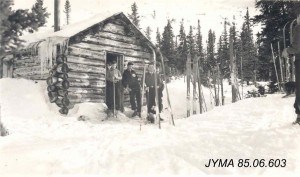
This mystery starts with a faded photograph that was published on the Jasper Yellowhead Museum and Archives (JYMA) Twitter account. It depicted two skiers smiling in youthful bliss, wearing old time ski gear while standing in front of a sturdy log cabin. The description was simple, elusive and frustratingly frugal on details: āSignal Mountain cabin 1934.ā
In the past Iāve written articles about the lost backcountry ski cabins and tent camps of JNP, now virtually extinct because of caribou conservation (on the verge of extinction as well.) Iāve also written about the hot female skiers of the 1930s and 40s and a ski rescue way up in Trapper Creek (Maligne Valley) in the 1930s. Along the way Iāve happily badgered Karen Byers at the museum for any information pertinent to these stories and read numerous books on JNPās past ski pioneers, hearty and tough characters that influenced and morphed the glory decades of backcountry skiing in JNP.
This time around the photograph in question immediately triggered questions about JNPās ski history. Why has no one mentioned this cabin? Who built it and when? Who used this cabin and how did they get up to the cabin? A trail, a fire road, open spaces, fire ravaged slopes? Lots of questions, but so far no answers, Iād have to filter through some known facts, a few off-shoot remarks written in books, and knit, pearl and cast on, the known wool strands together to solve this mystery of ski history.
In two separate books, which were written about Curly Phillips and George Camp, thereās a side paragraph about ski runs off Signal Mountain that ooze with intrigue.Ā My ski peak was tweaked, this is fascinating, and I wanted to solve this mystery, for ski historyās sake.
Curly Phillips was āthe manā and one of the most influential and enterprising characters from the early years of JNP who outfitted and guided visitors, adventure seekers, mountain climbers and hunters; a true visionary whose resourceful resume trumps anyone to this day. George Camp was another hardcore mountain man who loved working with the guides and outfitters of the early years and by 1940 had signed up to be a park warden.
By the time 1936 rolled around, both Curly and George had figured this ski thing out and wholeheartedly embraced it. Curly wrote, āGeorge and I had our kids up on Signal Mountain over New Year on a ski trip of four days. We have a six-mile run down off it to the canyon now that George and I have done most of the work on it.ā Frank Camp (Georgeās son) later explains, āus kids, dad and Curly were winter camping up a trail he had cut to timberline.ā Another innocent sentence only added more furrowed brows to the mystery. Why havenāt we found any evidence of this run? Why has no one else mentioned it and why did they winter camp if there was a cabin further up?
So many of the answers were historically vague. What we do know is in 1936 there was a six-mile ski run (just imagine how fantastic this would have been) cut by George and Curly, which ended at Maligne Road near the Maligne Canyon. In the 1915 Bridgeland survey of JNP, survey crews hiked up and camped to take precise measurements and photographs in all directions. There was no mention of a cabin.
Fred Brewster, a name synonymous with all early JNP tourism, recognized the value of a trail from Maligne Lake to Signal Mountain and by around 1937 the Skyline Trail came into existence after four years of building. Previously, all Maligne Lake seekers would ride to Buffalo Prairie, then up to Curator (on the south side of Big Shovel Pass) on a rough trail, which had been cut out by the Otto Brothers in 1911 in anticipation of Mary Schaefferās survey of Maligne Lake. Why was this cabin not mentioned?
If the 1930s was the age of skiing discovery, why did none of the early adopters such as Vern and Doug Jeffery, Joe Weiss, Fred Brewster, Frank Burstrom Sr. or Pete Withers ever mention or write about the cabin up on Signal Mountain? The only evidence is a faded photo on the JYMA twitter feed. Is this a historical hoax?
Confusion still gnaws at me; I schuss down a different chute. All through the 1940s JNP was building fire roads with the intent to build fire lookouts at select locations such as Signal, Palisades, Geraldine, Bald Hills and Devona. These stations were manned all summer, and several had cozy cabins situated near the lookouts. It would make sense the mysterious Signal cabin would be associated with the Signal fire lookout. Thereās one problem though, the lookout and the fire road werenāt built yet. Remember the date on the photo? 1934.
Thereās now a beaten path over to the museum; Karen is sick of me, my persistent questions are wearing thin, answers might as well be from Mars. To add more fuel to the mystery, Iāve since discovered other photos of skiers at the Signal Mountain cabin dating from 1933 well into the 1940s and this cabin was used as a fire lookout cabin once the road was built.
My exhausted surmise is weāll never know who constructed this purpose-built cabin. The early skiers of JNP enthusiastically embraced Signal Mountain, but its cabin and the details will remain a mystery in ski history.
Loni Klettl
Special to the 51°µĶų
